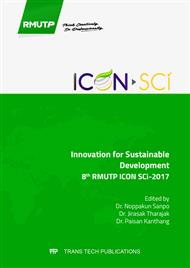[1]
M. Acosta, N. Liu, M. Deluca, S. Heidt, I. Ringl, C. Dietz, R. W. Stark, W. Jo, Tailoring ergodicity through selective A-site doping in the Bi1/2Na1/2TiO3-Bi1/2K1/2TiO3 system, J. Appl. Phys. 117 (2015) 134106-1-8.
DOI: 10.1016/j.jmat.2020.11.002
Google Scholar
[2]
R. A. Malik, A. Hussain, A. Maqbool, A. Zaman, T. K. Song, W. J. Kim, M. H. Kim, Giant strain, thermally-stable high energy storage properties and structural evolution of Bi-based lead-free piezoceramics, J. Alloy. Comp. 682 (2016) 302-310.
DOI: 10.1016/j.jallcom.2016.04.297
Google Scholar
[3]
A. Ullah, C. W. Ahn, S. Y. Lee, J. S. Kim, I. W. Kim, Structure, ferroelectric properties, and electric field-induced large strain in lead-free Bi0. 5(Na, K)0. 5TiO3-(Bi0. 5La0. 5)AlO3 piezoelectric ceramics, Ceram. Inter. 10 (2010) 1174-1181.
DOI: 10.1016/j.ceramint.2011.05.013
Google Scholar
[4]
C. Kruea-In, S. Inthong, W. Leenakul, Effects of NiO nanoparticles on physical and mechanical properties of BNKT lead-free ceramics, Appl. Mech. Mater. 866 (2017) 282-286.
DOI: 10.4028/www.scientific.net/amm.866.282
Google Scholar
[5]
K-N. Pham, A. Hussain, C. W. Ahn, I. W. Kim, S. J. Jeong, J-S. Lee, Giant strain in Nb-doped Bi0. 5(Na0. 82K0. 18)0. 5TiO3 lead-free electromechanical ceramics, Meter. Lett. 64 (2010) 2219- 2222.
DOI: 10.1016/j.matlet.2010.07.048
Google Scholar
[6]
P. Jaita, P. Jarupoom, R. Yimnirun, G. Rujijanagul, D. P. Cann, Phase transition and tolerance factor relationship of lead-free (Bi0. 5K0. 5TiO3-Bi(Mg0. 5Ti0. 5)O3 piezoelectric ceramics, Ceram. Int. 42 (2016) 15940-15949.
DOI: 10.1016/j.ceramint.2016.07.088
Google Scholar
[7]
A. Hussain, J. U. Rahman, A. Zaman, R. A. Malik, J. S. Kim, T. K. Song, W. J. Kim, M. H. Kim, Mater. Chem. Phys. 143 (2014) 1282-1288.
Google Scholar
[8]
X. Wang, B. Li. X. Li, L Li, and Z. Gui, The dielectric properties of ultrafine-grained BaTi1-xZrxO3 based ceramics prepared by a novel Integrated Ferroelectrics. 61 (2004) 173-176.
DOI: 10.1080/10584580490459198
Google Scholar
[9]
J. Ryu, J. J. Choi, H. E. Kim, Effect of heating rate on the sintering behavior and the piezoelectric properties of lead zirconate titanate ceramics. 84 (2001) 902-904.
DOI: 10.1111/j.1151-2916.2001.tb00766.x
Google Scholar
[10]
X. H. Wang, X. Y. Deng, H. Zhou, L. T. Li, and I. W. Chen, Bulk dense nanocrystalline BaTiO3 ceramics prepared by novel pressureless two-step sintering method, J. Electroceram. 21, (2008) 230-233.
DOI: 10.1007/s10832-007-9143-1
Google Scholar
[11]
S. M. Rhim, H. Bak, S. Hong, and O. K. Kim, Effect of heating rate on the sintering behavior and the dielectric properties of Ba0. 7Sr0. 3TiO3 ceramics prepared by boron-containing liquid-phase sintering, J. Am. Ceram. Soc. 83, (2000) 3009-13.
DOI: 10.1111/j.1151-2916.2000.tb01675.x
Google Scholar
[12]
N. D. Quan, N. V. Quyet, L. H. Bac, D. V. Thiet, V. N. Hung, and D. D. Dung, Structural, ferroelectric, optical properties of A-site modified Bi0. 5(Na0. 78K0. 22)0. 5Ti0. 97Zr0. 03O3 lead-free piezoceramics, J. Phys. Chem. Solid. 77, (2015).
DOI: 10.1016/j.jpcs.2014.10.010
Google Scholar
[13]
N. B. Do, H. D. Jang, I. Hong, H. S. Han, D. T. Le, W. P. Tai, and J. S. Lee, Low temperature sintering of lead-free Bi0. 5(Na0. 82K0. 18)0. 5TiO3 piezoelectric ceramics by co-doping with CuO and Nb2O5, Ceram. Inter. 38S, (2012) S359-S362.
DOI: 10.1016/j.ceramint.2011.05.012
Google Scholar
[14]
R.D. Levi, R. Clive, Solid solution trends that impact electrical design of submicron layers in dielectric capacitors, Pennsylvania State University (2009) 6-10.
Google Scholar


